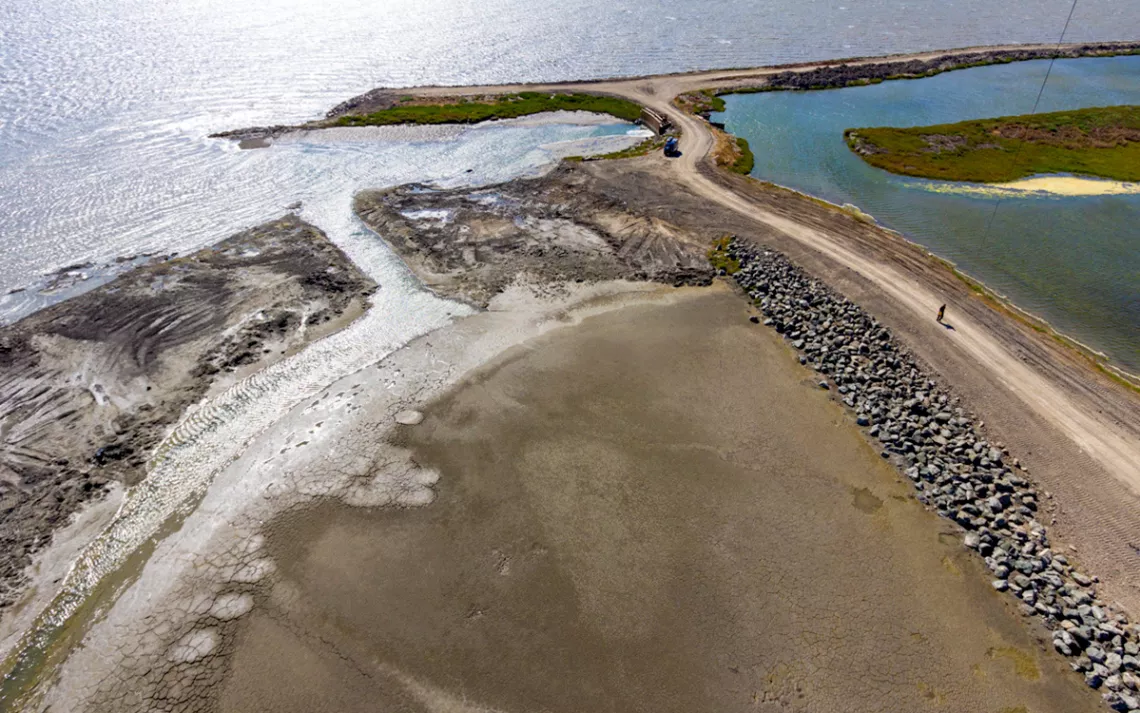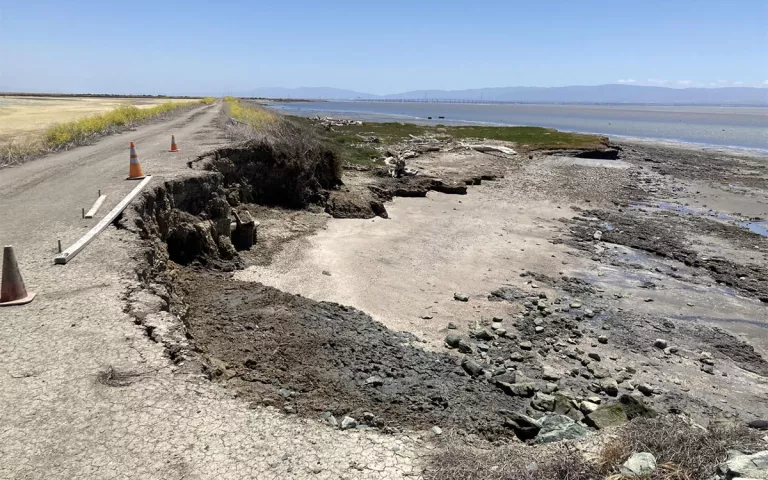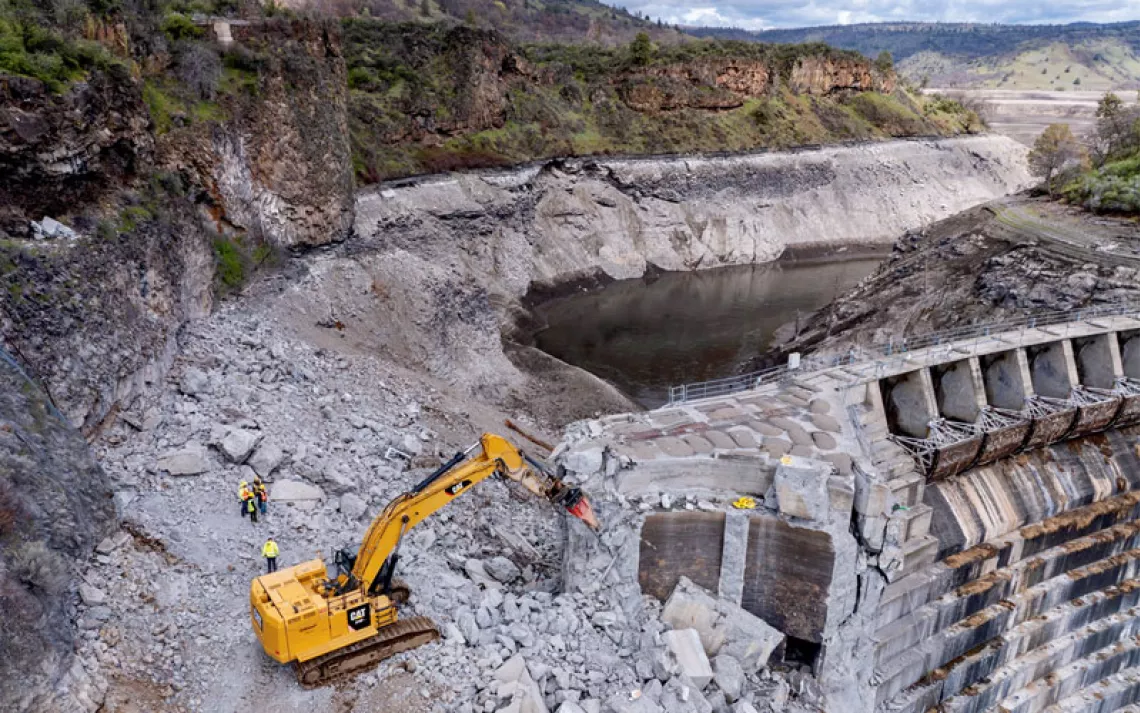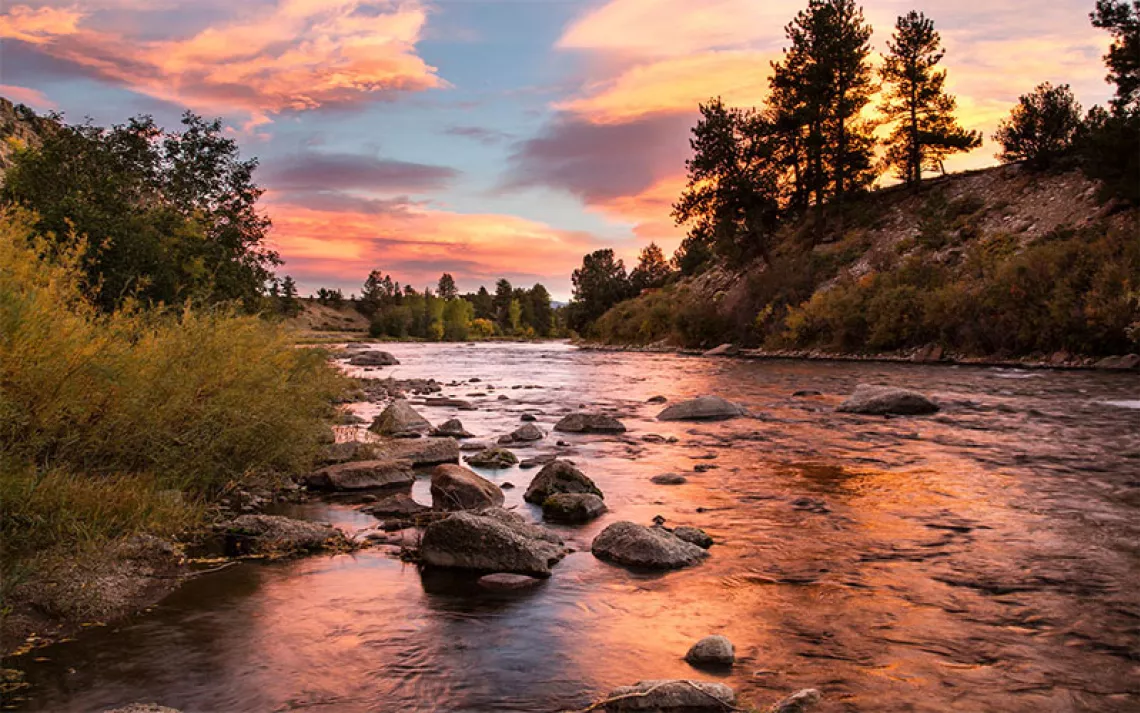A Tale of Two Sea Level Rise Solutions
Coastal communities in California brace for the future in radically different ways

Mount Eden Creek meets the San Francisco Bay. The creek runs through former industrial salt ponds that today are part of a wetlands restoration project to help bolster the Bay Area against sea level rise. | Photo by Cris Benton
On a mid-winter morning in central California, Alyson Hunter and Bruce Delgado gathered at the Marina State Beach parking lot, the sea raging in the distance. Heavy rolling waves gushed toward the shore, crumbling before the dune. The temperature was in the high 40s, though the morning sun was strong and the air was nearly still.
Delgado, the mayor of Marina, had arrived in his signature white Prius, splattered with the neon paint of children’s handprints and handwritten notes reading “Marina rocks!” and “Honk at me.” Hunter, the city’s planning services manager, sported a City of Marina baseball cap, patched with the city emblem of a full sun and natural shoreline.
At the edge of the parking lot, orange cones and caution tape blocked off where a recent storm had pulled sand out from underneath the lot, cracking the concrete and leaving behind a gully that now stretches to the sea.
“This is just a recurring event here,” says Hunter. “The concrete is gonna fall off eventually.”
In December 2023, a storm in the Pacific Ocean compounded a freak high-tide event, pummeling the West Coast with 25-foot waves, flooding cities and beaches, and eroding shorelines. Though the effects of this storm were short-lived, flooding from rising oceans—which hit record-high levels globally in 2023—and higher storm surges are projected to become a more regular occurrence. The scene that day at the Marina State Beach parking lot was a portent of what’s to come.
Like all communities coming to terms with sea level rise, cities along California’s coast face one crucial choice: fight or flee. Climate models project Californians will see one foot of sea level rise in the next 25 years and three feet by the end of this century. How the state chooses to manage this is especially weighty because of its scale: California coastline accounts for a little less than half of the contiguous West Coast's total mileage. With more people in California living below one meter (3.3 feet) of elevation than any other state except Louisiana, Californians are particularly vulnerable. Given the extent of the projected impacts, coastal communities nationwide are looking to California as a model for how to adapt to rising seas.
Without a coordinated state-wide plan for sea level rise, however, cities and towns have arrived at vastly different approaches to their shared problem. This lack of coordination along the coast could present additional challenges down the line, sparing certain areas at first but ultimately worsening the impacts of sea level rise for more economically and environmentally vulnerable communities.
Marina is surrounded by beautiful landscape on all sides, with the Santa Cruz Mountains to the north and Big Sur to the south. Unlike the nearby city of Monterey, where houses perch atop eroding cliffs, Marina’s coast has remained largely natural, with very little residential or private development. Large swaths of Marina’s shoreline have been protected as state parks, nature preserves, and the Fort Ord National Monument, making sea level rise planning in Marina fairly straightforward and uncontroversial.
Marina, where residents speak 52 different languages, also stands out as the most racially diverse city in Monterey County. One-third of the city is also low-income, and 11 percent live below the poverty line. The city has made an effort to prioritize these historically disadvantaged communities in its sea level rise planning.
With a map of projected sea level rise impacts in hand at the beach, Hunter pointed out the nearby areas that will be affected by dune erosion and storm surges by 2030, 2060, and 2100, marked in varying shades of blue. The entire parking lot, in addition to the Marina Coast Water District building, will be vulnerable to erosion as soon as 2060, she says.
Despite evidence of erosion at the edge of the lot, Delgado remains firm in his stance: no seawalls. These structures, typically made of concrete, are built along shorelines to protect human communities from flooding, but they also stop ecosystems from adjusting themselves. Marina’s Draft Coastal Hazards and Sea Level Rise Land Use Plan, which is currently awaiting approval from the California Coastal Commission, explicitly bans this kind of hard armoring along the coast. Instead, Marina plans to relocate infrastructure and let the dunes retreat inland with sea level rise—a natural process—so the beach can maintain its width.
“Seawalls are good against defending the coast, but they're not good for protecting beaches,” says Patrick Barnard, a research geologist at the United States Geological Survey’s Pacific Coastal and Marine Science Center. Confirming Delgado’s position, he explains, “The second you draw a line in the sand with a seawall, that shoreline can no longer migrate inland, and it tends to drown beaches and destroy beaches over time.”
Those who participated in public meetings “wanted us to have as much natural beach as possible,” says Delgado. “It’s one of the best things we have in the community. Why would we want to bar it?”
The relatively short list of infrastructure the city will likely need to relocate includes the Marina State Beach access and parking, a resort, district offices for the Marina Coast Water District, a sewer pump station, an inactive water treatment facility, and a groundwater supply well. Hunter acknowledges how lucky Marina is to be able to retreat. She doesn’t envy the feat of their neighboring city, Monterey, where millions of dollars of private property are at risk. “They’re gonna have a lot of challenges,” says Hunter.
And as Marina gears up for the incoming seas, a new threat looms. “We're very conscientious of the threat of gentrification,” says Hunter. As the ocean encroaches inland, areas like Marina, which are relatively less threatened and are well prepared, become increasingly desirable—a newly observed pattern referred to as “climate gentrification.”
“The effects of sea level rise are going to be our generation’s redlining,” says Amanda Stoltz, social scientist and doctoral candidate at the University of California, Santa Cruz. Not only are lower-income and BIPOC communities already bearing the brunt of the climate crisis, but also rising real estate prices may continue to push those communities out of climate-safe neighborhoods and into areas more at risk.
As Delgado and Hunter gazed out at the shore, they seemed humble yet proud. To them, retreating means acknowledging their vulnerability to the power of the sea in this human-induced climate crisis. While other coastal towns like nearby Pacifica and Del Mar have vowed not to consider managed retreat due to outcry from residents, Delgado sees things differently.
“You fight nature to your own peril and eventually you are going to lose,” he says. “You either face it and plan for it, or you deny it.”
Just a two-hour drive up the coast from Marina lies a 15,100-acre wetland rehabilitation effort—and a community taking a radically different approach to sea level rise. In January 2024, during one of the highest tides of the year, Dave Halsing, executive project manager of the South Bay Salt Pond Restoration Project, was curious to see how the wetland restoration effort would fare. So he visited Eden Landing, one of the project’s sites in the East Bay, where clouds hung heavy and low, but the rain held off for the hour Halsing spent touring the site.
Beginning in the mid-1800s, industrialized salt production picked up here—the region once produced an estimated million tons of salt per year—costing the bay 85 percent of its tidal wetlands. For the last two decades, the project has been restoring this type of ecosystem, which is crucial as a buffer between ocean and land; without it, land becomes more vulnerable to high tides. Tidal marsh vegetation and the soil that lies beneath it reduce the energy of water as high tides, waves, and storm surge flow through them, protecting shorelines from erosion. As sea level rise awareness grew and local communities came to recognize the importance of tidal marshes in reducing flooding, the project's work took on an additional purpose.

Erosion of old salt pond berms on the outer edge of southern Eden Landing. The pond behind the berm is in the process of being restored to tidal marsh, which will help protect the communities inland from tidal flows and storms. | Photo by Dave Halsing
As Halsing drove along Mount Eden Creek, a waterway that snakes through the reserve, he passed hundreds of acres of restored marshland—a mosaic of lush vegetation, sloughs, mudflats, and shallow natural ponds. Halsing slowed the car to point out diving ducks, herons, and egrets flying above the marsh, which he identified with enthusiasm. A hawk hovered above the marsh, hunting for prey, fighting against the breezy bay winds. The marsh is rich with threatened and endangered species, including the salt marsh harvest mouse and 80 percent of the South Bay’s western snowy plovers, which were camouflaged amid scattered oyster shells on a dried salt pond.
Vegetation peaked out from above the especially high tide—a sign to Halsing that the buffer is working, slowing and absorbing one of the highest tides of the year.
“Nature-based solutions can be more cost effective,” says Hasling, whereas seawalls can have adverse effects on neighboring communities. Studies have shown that building seawalls in one area can simply transfer the rising waters elsewhere, as waves reflect off the concrete and get amplified onto nearby communities.
However, when sea level rise exceeds the marsh’s capacity to absorb water, coastal communities may decide that seawalls are necessary to protect themselves. Both seawalls and tidal marshes have their limitations, but Halsing says they can work together to mitigate their weaknesses: He says marshes can act as a buffer between seawalls and the bay, reducing the force of the water rushing toward them and making it less likely that those walls degrade over time.
Many of the Bay Area’s lowest-income communities are located along the shores in areas prone to flooding. “In a way, [those communities] are the ones that will receive the greatest amount of protection from having marshes,” Halsing says. Like Marina, cities with increased flood protection risk “climate gentrification,” particularly in the Bay Area, where multibillion-dollar tech companies have built campuses on flood-prone ground and are likely to seek shelter in the near future.
As enthused as he is about the restored marshland and its potential, Halsing is conscious of its limitations. “This is not like a magic bullet against all of the problems,” he says.
Halsing looked out at the widened tidal channel and a footbridge that during the high tide is only a few feet from being underwater. “If the sea level rise is high enough, the marshes will all be drowned,” he says, warily. At that point, the marsh restoration “won’t matter.” Still, he says, the project buys the Bay Area some more time to figure out an alternative plan.
California’s piecemeal approach to sea level rise poses some notable risks—like climate gentrification and increased flooding for towns without seawalls that border towns with seawalls. As far as state-wide coordination goes, “there's definitely a lot of room to improve,” Barnard says. The California Coastal Commission is the saving grace, he says; it is tasked with approving every city’s sea level rise adaptation plan. The commission reviews each plan to ensure its policies are in alignment with the Coastal Act, one of California’s main coastal management laws that seek to protect the coast and mitigate the effects of sea level rise. Barnard says that the commission can also alert communities to what neighboring cities' plans are and how they might be affected.
Despite the issues that California’s patchwork of solutions present, the reality is that cities along the coast each face a unique set of circumstances. Managed retreat, though feasible in Marina, would not be possible in the same way—never mind embraced—in a city with more coastal development. Likewise, the South Bay’s wetland restoration is possible due to the region’s salt-producing past and the local communities’ desire to protect what’s been built there.
Still, common value runs through these varied responses. The decision to fight, in the Bay Area, and conversely, the decision to flee, in Marina, both stem from peoples' deep attachment to the coast and a desire to hold onto what they love in our fast-changing, ever-evolving climate.
 The Magazine of The Sierra Club
The Magazine of The Sierra Club



